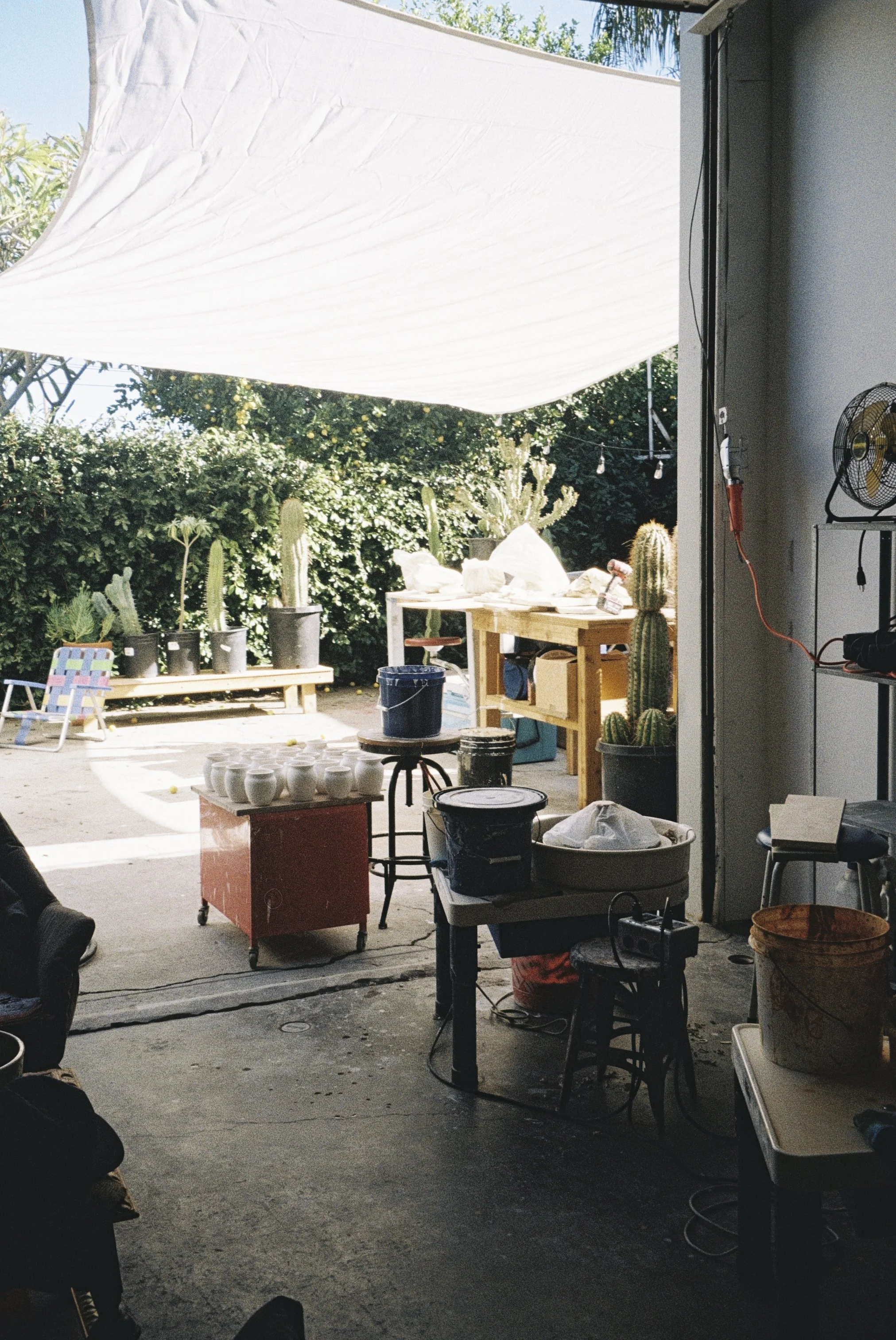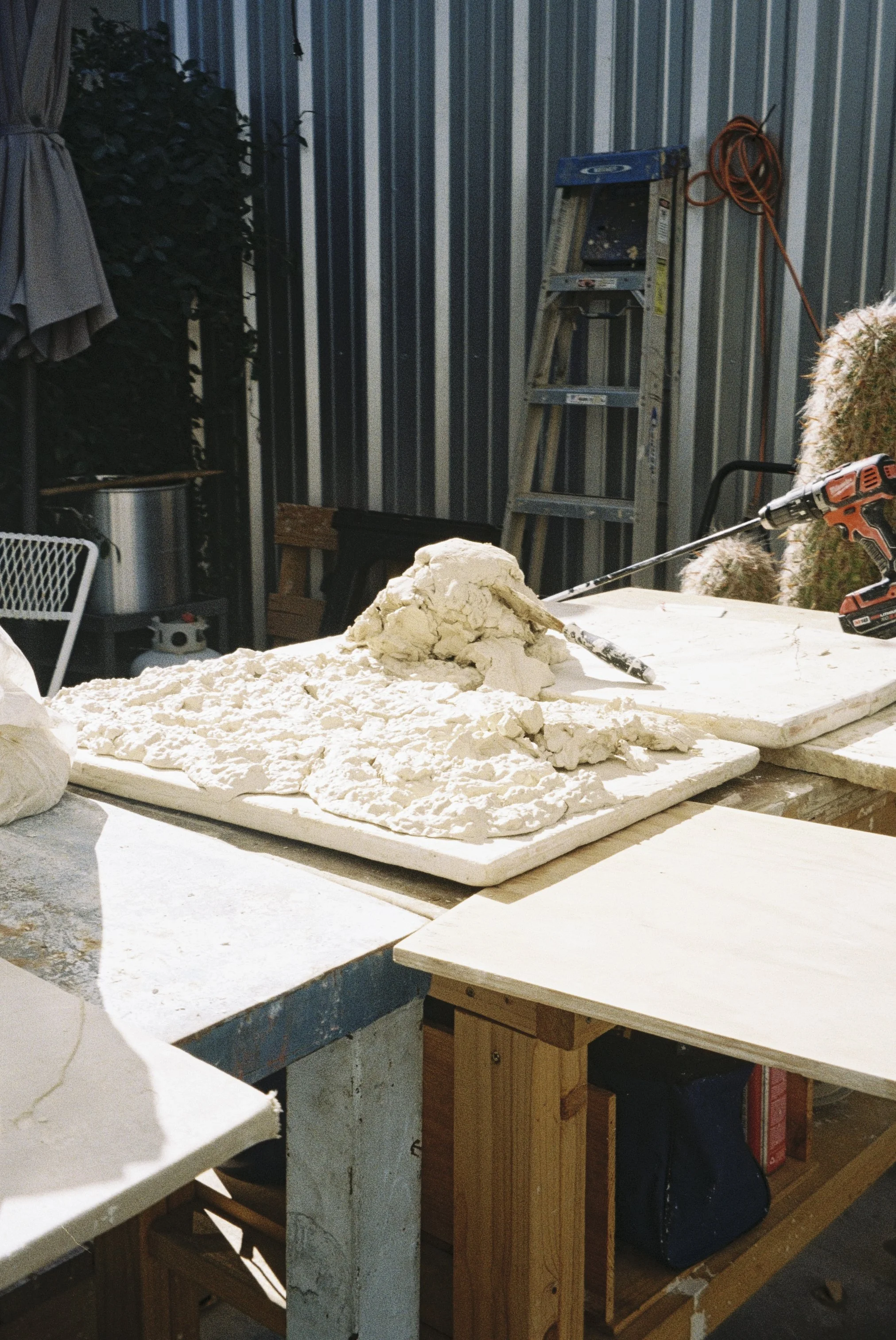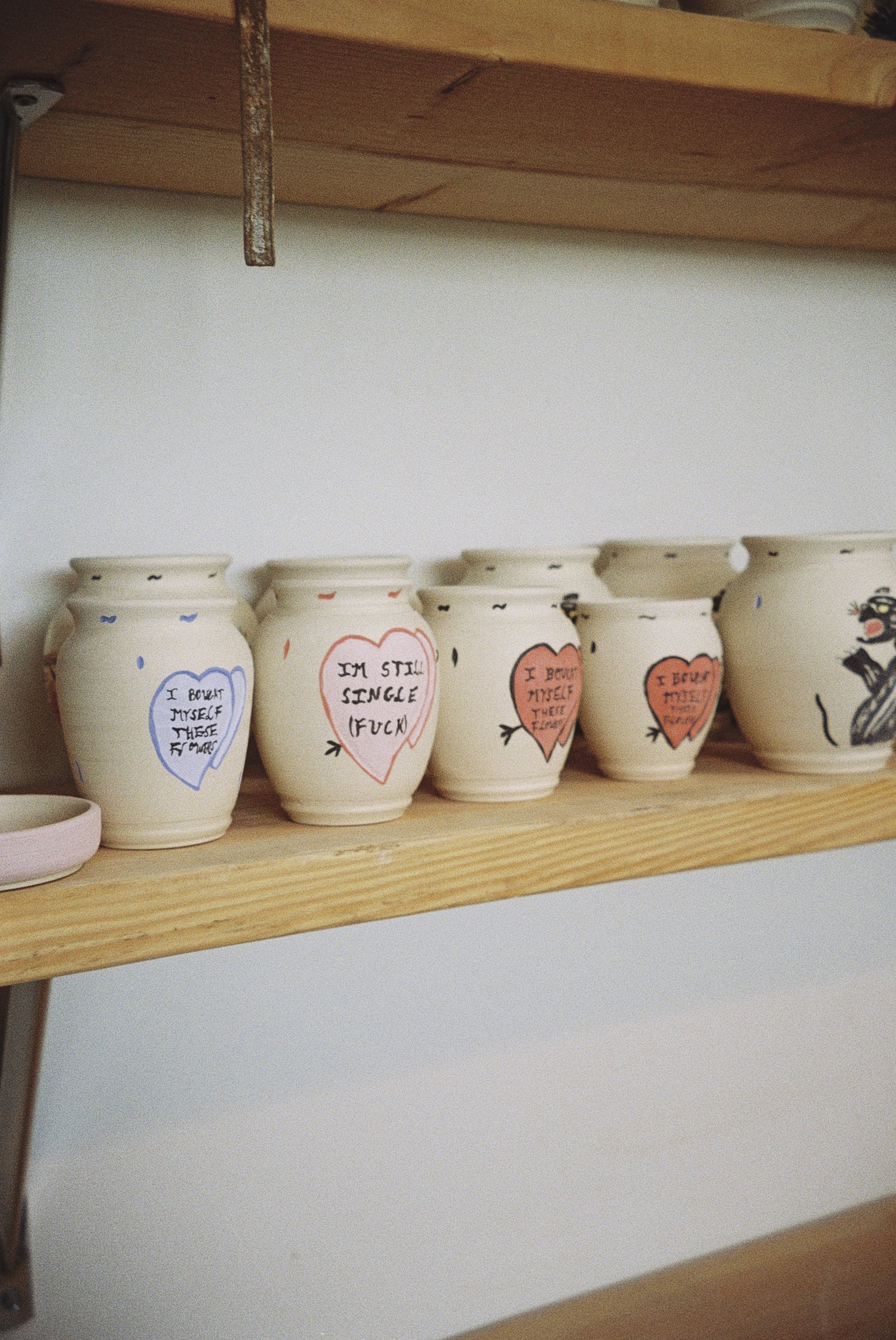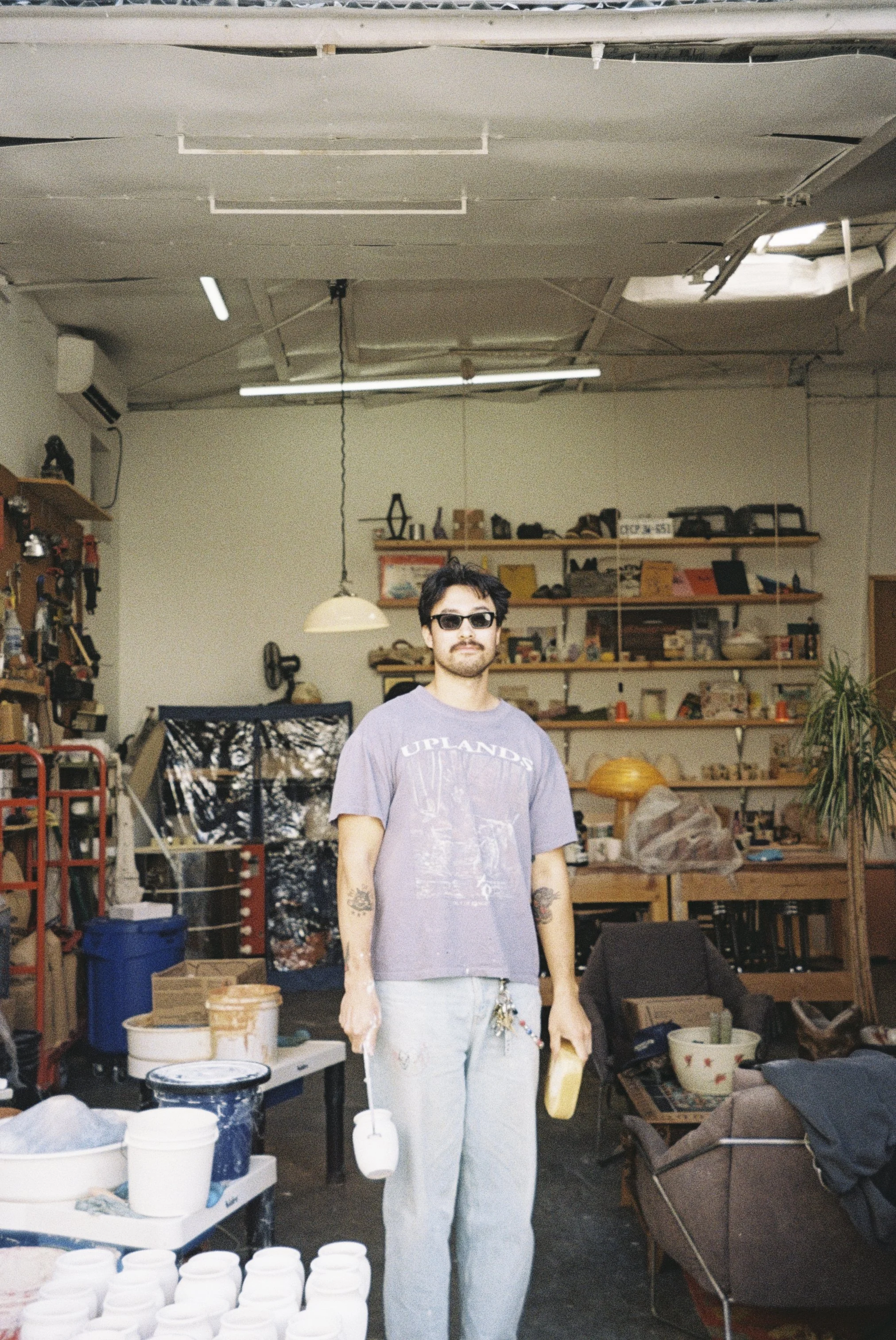Everything happens in pieces — Daniel Dooreck
The East side of Los Angeles has cultivated an intriguing art scene. The city that has always felt so artistically exposed has slowly become more and more intimate. Stars and angels still shine, they only seem to do it in unique places — or fascinating ateliers.
I recognized the smile from afar—a smile I had only seen in social media, and well, the LA Times. Daniel opened the front door of his studio while I delivered the goods: two cups of drip coffee from Café Telegrama. He greeted me and some eager visiting customers with a dry clay handshake — very artsy.
Daniel Dooreck is a potter in East Los Angeles. About five years ago, he founded Danny D’s Mud Shop, a ceramics shop that consists of wheel-thrown pieces. All free-hand carved and painted, made from a mix of porcelains and a sandy red clay called Santa Fe. His artwork is usually inspired by Western, American, folk, and indie art.
I visited his space on a recent afternoon. Beyond an ordinary workshop, his studio is a combination of pegboard walls, hardware store items, and a large display of Danny’s best — tableware, planters, vases, and my favorite: the copitas, perfectly set on wooden shelves. The space is almost an illustration of a hyperactive mind: a multicolored, untidy (but well-formulated) playground with tons of fun, cowboy vibes.
“I wanted to find hobbies and this one was successful.”
The patio is an airy treasure. Piles of clay, a throwing wheel, cacti, and a glazing area stayed behind Danny as he glazed some cups, slowly spinning them with a clipper so they could get some air. It was a serene choreography. I sat on what I later knew was a 1981 truck bench seat while we spoke about a planter I had just noticed. There were cracked pieces of ceramics in it, interesting poetry could come out of that.
J: I read that you don’t call yourself an artist, why?
D: I don’t know, I’m a potter. I don’t want to be pretentious. I don’t like galleries, I find it’s kind of a rip-off.
Humans have this desire to build something sustainable. Something visible that comes out of one’s hands. With clay, there’s no room for shyness. Every small decision is visible, and it becomes part of the body of the finished product. That’s the beauty of pottery, the traces of the making process are engraved all over the piece; the initial intention, the hesitation, the freedom, the “mistakes.” It’s the unexpected type of art that catches people’s attention.
J: Working with your hands is very reflective, what goes through your mind while wheel throwing?
D: A lot of times I’m distracted but I just stick with it. I do so many of these now, it’s muscle memory. There’s not too much deep thought. I’m just like, oh, that’s a nice shape, I’ll do it again. A lot of times I just put a movie on the projector and I can throw to that which is nice.
You can tell Danny has fun at work. Not only do you see it in his illustrations. Between studio rearrangings, antique items, aged rugs, and tile coffee tables, Danny’s space just makes sense. Or maybe it’s the lack of it that makes it special. I spotted on the corner a few cups inspired by Valentine’s Day with carvings that read “I bought myself these flowers” and “I’m still single (fuck)”. Ideal, right?
J: How did your space begin taking shape?
D: I started by putting up pegboard, that’s been kind of fun for me. You just hang this up and it looks good. I had a lot of shit so this is pretty good to organize.
J: It almost looks curated.
D: Right but it’s not. It just fits in different spots. It’s pretty cheap, too. It’s nothing fancy. Shelving is really important and then little things start coming along—the wheels and then the clay everywhere.
J: Is it always changing?
D: Yeah, it is. I change it often. I like this setup right now.
J: Do you think this space describes you?
D: Yeah, I think so. I think it represents my work.
J: It feels like home.
D: The best art comes out of good studios. It was really important to me to make a studio right. Spend the money, I’ll make it back later. People walk in here and they are like, “Wow.” That’s the reaction I want. I don’t see it anymore because I’m here all the time.
J: What’s your favorite part?
D: Right now is the sitting area, next to the back wall. I worked hard on this shipping area ‘cause shipping is so miserable. I fucking hate shipping.
J: Do you handle everything by yourself?
D: No, I have two assistants.
J: Do you have a favorite piece or collection?
D: I think my favorite pieces are these lamps, and the big planters next to you, too. Those were my first big pieces. Cool, right? They cracked and I can’t sell them now.
J: What does LA look like for artists?
D: It’s great, I’ve had a good experience. I think it can be intimidating, especially if you don’t have, maybe, connections. I don’t blame people for feeling intimidated. It’s an expensive city to exist in so a lot of artists who aren’t selling or work so much don’t do art anymore. It’s a cycle. At the end of the day, it’s expensive and you gotta pay your bills, I get it. I love LA, though. I think there’s a great community if you find the right one. You gotta be with the right artists, too. You gotta make sure that the artists are supporting you and that they create a good space and energy to exist in. That’s what I do with this studio. Some studios are quiet and depressing, I don’t do that, fuck that shit.
J: Do you feel any responsibility while making art?
D: I have a financial responsibility with myself, my space, my employees, and this type of thing. But no, I make what I want. Not everyone has to like everything. There are so many fucking people out there, and there’s always gonna be someone who doesn’t like your work.
J: Do you still get excited when you get an order?
D: Yeah, I do. It’s not like it used to but yeah I definitely do. Some orders are better than others, when people buy the cool shit that I think is cool. Everything’s cool but there are some pieces where I’m like, those are great! I’m very grateful.
J: Do you have a morning ritual?
D: I shower, have coffee, open the windows, write down my to-do’s now every day, I’ll check my email, my DM’s, notifications if there’s anything important and then I´ll probably come to the studio, and decide what I want to do.
J: Do you have any other hobbies?
D: I like cars. I like being outside, I like exercising, being with friends, and traveling. I like bicycling but I fell off my bike so I haven’t gone back.
J: I see a surfboard up there, do you spend time in the ocean?
D: Not as much. I like the ocean, I’m not an ocean guy but I have a surfboard for when my friends want to go to the ocean.
J: Favorite drink?
D: Cold beer or a good cup of hot coffee.
J: Do you have a favorite smell?
D: Fresh rain is good. I’ve been burning a lot of incense, palo Santo, maybe that’s it.
The room was catching the perfect amount of sunlight. Danny was still glazing and moving all over the studio. It was time to take some last photos. He mentioned he is someone who works on his terms. When I asked about his definition of happiness, he responded smoothly. “If I can wake up and do what I want to do and some people are buying it, people around me, my friends admire me and I admire them and we support each other, that’s enough for me. I don’t need to do much, it’s a deep question.”
D: “Nah, wait, let’s lose the sunglasses.”
Words and photos by Jossie Ayón
Special thanks: Daniel Dooreck
Los Angeles, US
Visit Danny’s online shop: https://www.dannydsmudshop.com/














